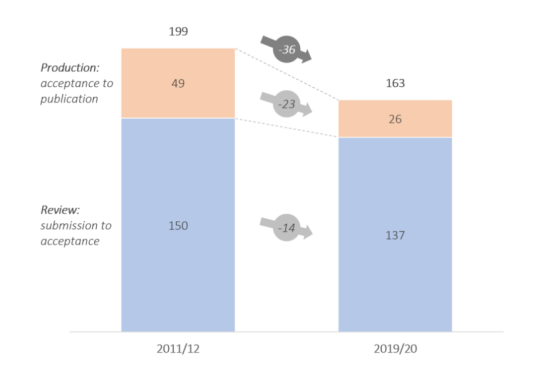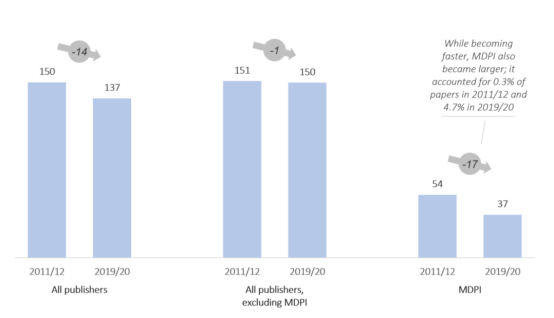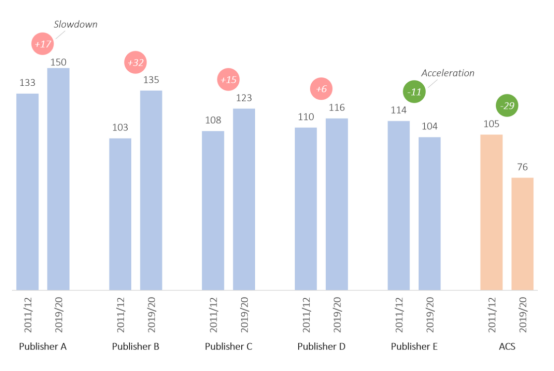Please click the button below to go to our email login page
|
Fast and Slow: Publishing speed changes of major publishers in a decadeThe publication cycle is one of the most vital criteria for authors to select a journal. In surveys conducted by Springer Nature in 2015, Editage in 2018, and Taylor & Francis in 2019, the cycle of peer-review process (from submission to acceptance) and production process (from acceptance to publication) is considered important by most researchers. In addition, the internal survey results of Elsevier indicate that the publishing speed is among the top three considerations when authors select a journal. With the rise of MDPI, the publishing speed has become an imperative issue for major publishing houses. MDPI generally publishes papers within less than 50 days after submission of a manuscript. Further development of pre-print and pre-publication platform calls for higher requirements at the publication cycle of traditional publishers. Christos Petrou, the founder and chief analyst at Scholarly Intelligence, analyzed the changes of publishing cycle of the ten largest publishers in a recent decade, and published an article entitled “Publishing Fast and Slow: A Review of Publishing Speed in the Last Decade”.
The survey collected the date of submission, acceptance, and publication of the published articles and reviews between 2011 and 2012 and between 2019 and 2020. The samples included over 700,000 randomly selected papers published in more than 10,000 journals. (1) Publication is accelerating The survey results reveal in the past decade, publishing has become faster. In 2011-2012, an average of 199 days was needed for papers to be published, compared with 163 days in 2019-2020. The time is primarily shortened at the production stage (about 23 days faster) and secondarily at peer review (about 14 days faster). In 2011, three of the four large traditional publishers (Elsevier, Wiley, Springer Nature, and Taylor & Francis) took over 50 days to publish accepted papers. By 2020, the four publishers can publish accepted papers within 40 days.
(2) Except MDPI, the speed of peer review appears invariable The acceleration of peer review is mainly driven by MDPI, while the field of chemistry is primarily promoted by ACS. These two publishers stand out in virtue of fast speed. Meanwhile, the peer-review speed for most other major publishers remains the same pace or is slowing. According to the data in 2020, the average acceptance time of MDPI is 36 days and publishing time is 5 days after acceptance. ACS is the second fastest publisher in this survey, with the acceptance time of 74 days and the publishing time of 15 days after acceptance. With the expansion of MDPI, the peer-review speed across publishing is getting faster. Including MDPI, the peer-review speed in the whole industry in 2019-2020 was 14 days faster than in 2011-2012 (from 150 days to 137 days). Except MDPI, the speed has barely changed (from 151 days to 150 days).
(3) Slowing down is avoidable While the operational performance of MDPI makes people question the preciseness of its peer-review process, the same criticism is not applicable for ACS, the leading publisher in the field of chemistry with several top-ranked journals. Notably, 55 of ACS’s 62 journals are ranked in the top 25% on Scimago, and ACS has 5 top-20 journals among over 400 journals in the field of “Chemistry”. Based on strict screening, the peer-review speed of ACS is still fast. The acceptance time of ACS has been accelerated by 29 days between 2011 and 2022 relative to that between 2019 and 2020, with an average acceptance time of 76 days after submission.
The performance of ACS shows that it is possible to have high editorial standards and faster speed at the same time. The slow publishing speed of traditional publishers is not inevitable, but the consequence of operational inefficiencies. |




